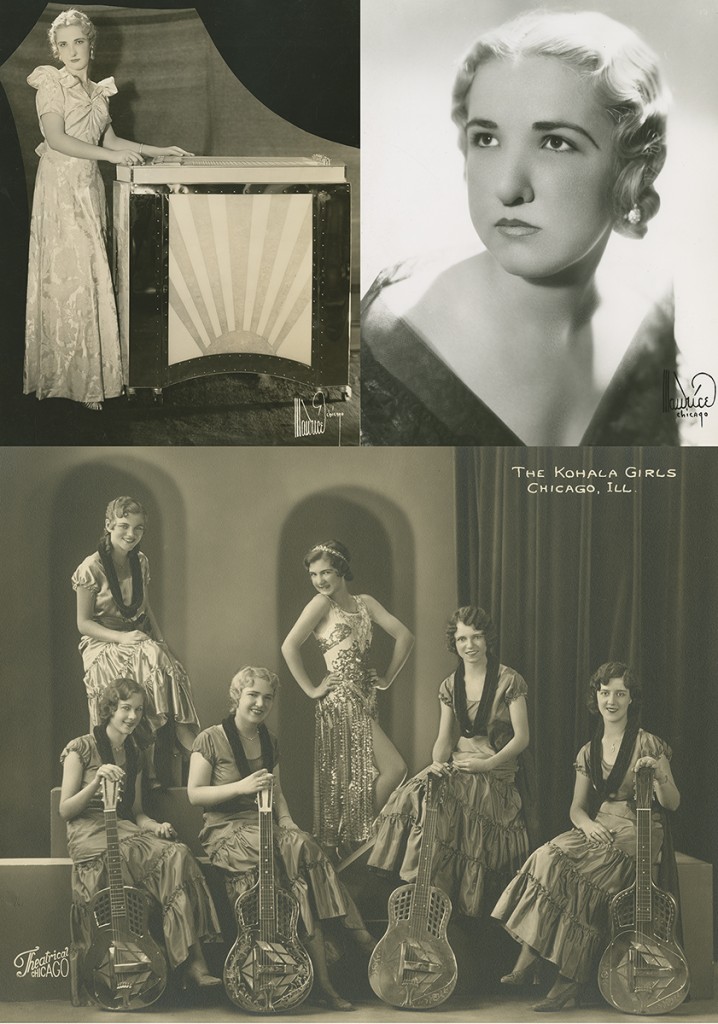
Letritia Kandle standing with the Grand Letar, c. 1937 (top left), Letritia Kandle portrait, c. 1940 (top right), and the Kohala Girls with Letritia, c. 1934 (seated front row).
The Sousa Archives acquired Letritia Kandle’s personal papers and Hawaiian guitars from her friend and fellow steel guitar player, Paul Warnick, on April 16. The Center is currently processing the paper records and historical instruments from this exciting new Hawaiian music collection which complements the Elbern H. “Eddie” Alkire Personal Papers and Hawaiian Music Instrument Collection which was acquired by the Sousa Archives in 2006. This acquisition was made possible through the help of John Troutman, a leading Hawaiian music scholar, who has made extensive use of the Alkire collection over the years.
Letritia, the only daughter of Charles and Alma Kandle, was born and raised in Chicago, Illinois. Her earliest music lessons were on the piano, but in 1928 she switched to the Hawaiian guitar after watching the film, The Cisco Kid, and talking with her music teacher. Her early steel guitars included a Koa Weissenborn and a National Style 2 resophonic guitar. In 1933 Letritia attended the Chicago World’s Fair and met Geroge Kealoha Gilman who mentored her in Hawaiian music and lore, and the following year she formed an all-girl music ensemble that played matching National Resophonic guitars that called themselves The Kohala Girls. Several years later the ensemble switched to electric lap steel and double-neck steel guitars.
While waiting for an appointment during the 1930s Kandle came up with the idea of creating an electronic twenty-six string guitar that would use colored lights to change colors as the instrument was being played. She envisioned a guitar that would enable her to stand while playing it and would have a full sound like an organ and produce tones like a vibraharp. In 1937 Letritia’s father helped construct her large console Hawaiian guitar that consisted of top cast in aluminum with one eight-string and three six-string necks, sides made of wood that was covered with chrome-plated steel, and top and side panels made of glass. National installed electronic pickups and a 20-watt amplifier that utilized two twelve-inch JB Lansing field-coil speakers. Inside the glass panels a network of 120 colored lights that flashed and changed colors as it was played.
The instrument was premiered by Letritia, who was performing Hawaiian guitar with the Paul Whiteman Band, at Chicago’s Drake Hotel in 1937. The instrument was eventually named the Grand Letar by Whiteman based on the first two letters of Letritia’s name and the last three letters of the guitar. That same year Kandle demonstrated the Grand Letar at the 1937 National Music Trade Convention held in New York City.
In 1939 Letritia’s father constructed a smaller and more portable electronic Hawaiian guitar that did not have internal amplification or lights, and she used it as a replacement for the Grand Letar. When Kandle wasn’t performing with the Kohala Girls or directing the forty-nine piece Chicago Plectrophonic Orchestra, she ran a music school in Chicago’s Kimball Building and wrote numerous articles several different music trade journals. In 1955 she married Walter Lay, a one-time bassist for the Chicago Plectrophonic Orchestra, and went to work for her father’s company which manufactured earth-boring equipment.